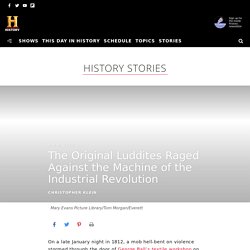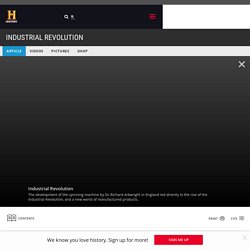

Untitled. On a late January night in 1812, a mob hell-bent on violence stormed through the door of George Ball’s textile workshop on the outskirts of Nottingham, England.

With handkerchiefs tied around their faces, the men slammed their targets with sledgehammers and fled, leaving behind five shattered knitting machines. The early 1800s was a time of economic upheaval for English hosiers, croppers and weavers. The decade-old Napoleonic Wars had halted trade and caused food shortages. And a change in men’s fashion from stockings to trousers had crippled England’s hosiery industry. On top of it all, the Industrial Revolution sweeping across the English countryside brought with it disruptive technology that allowed workers to produce knitted goods about 100 times faster than by hand. Claiming to take their orders from a “General Ludd,” the “Luddites” emerged as a violent force against changes in the textile industry. READ MORE: The Industrial Revolution The Legend of 'General Ludd' Historia de la letra y la música de “La Internacional”
En 1871, un obrero francés que participó en la revolución de 1848 y fue miembro del consejo de uno de los municipios y las barricadas de la Comuna de París, Eugène Pottier, escribió la letra de la que sería "La Internacional", el himno de los trabajadores de todo el mundo.

Pottier había organizado a los diseñadores de telas (éste era su oficio, además de escritor) incorporando su gremio a la AIT (Primera Internacional) desde 1864. Luego de la derrota de la Comuna se exilió en Inglaterra y EEUU, pero volvió a Francia en 1880. En 1886 compuso una canción en honor a la Comuna (ver video abajo). Murió en 1887, sin escuchar cantar "La Internacional". A su entierro acudió una manifestación obrera encabezada por la bandera roja.
Oliver Twist And The Industrial Revolution by Adithya Manoj on Prezi.
Industrial Revolution: Glossary and Terms for Kids. History >> Industrial Revolution Breaker boy - A worker in a coal mine whose job was to break up the coal into similar size pieces and to remove any impurities from the coal.

Many of these workers were young boys between the ages of 9 and 12. Bessemer process - A process that enabled the mass-production of inexpensive steel. It was invented by Henry Bessemer. Child labor - During the Industrial Revolution poor children were often put to work in factories. Cottage industry - An industry where the manufacture of products is primarily in homes by people using their own tools and equipment. Cotton gin - A device that separates the seeds from cotton fiber. Division of labor - When each worker has a specific task or role they perform. Factory System - A new method of manufacturing goods developed during the Industrial Revolution where products were made in large factories using division of labor and machinery. Rural - An area or region outside of town or in the countryside. Works Cited. Industrial Revolution Timeline. The Industrial Revolution. The Industrial Revolution (18-19th Century)
Children of the Industrial Revolution. Industrial Revolution - Facts & Summary. The textile industry, in particular, was transformed by industrialization.

Before mechanization and factories, textiles were made mainly in people’s homes (giving rise to the term cottage industry), with merchants often providing the raw materials and basic equipment, and then picking up the finished product. Workers set their own schedules under this system, which proved difficult for merchants to regulate and resulted in numerous inefficiencies. In the 1700s, a series of innovations led to ever-increasing productivity, while requiring less human energy. For example, around 1764, Englishman James Hargreaves (1722-1778) invented the spinning jenny (“jenny” was an early abbreviation of the word “engine”), a machine that enabled an individual to produce multiple spools of threads simultaneously. By the time of Hargreaves’ death, there were over 20,000 spinning jennys in use across Britain. Developments in the iron industry also played a central role in the Industrial Revolution.
Victorian Britain - Children in factories. Turning Points in History - Industrial Revolution. POLITICAL THEORY - Marx. How inventions change history (for better and for worse) - Kenneth C. Davis. A factory worker in the Industrial Revolution. La Revolución Industrial.